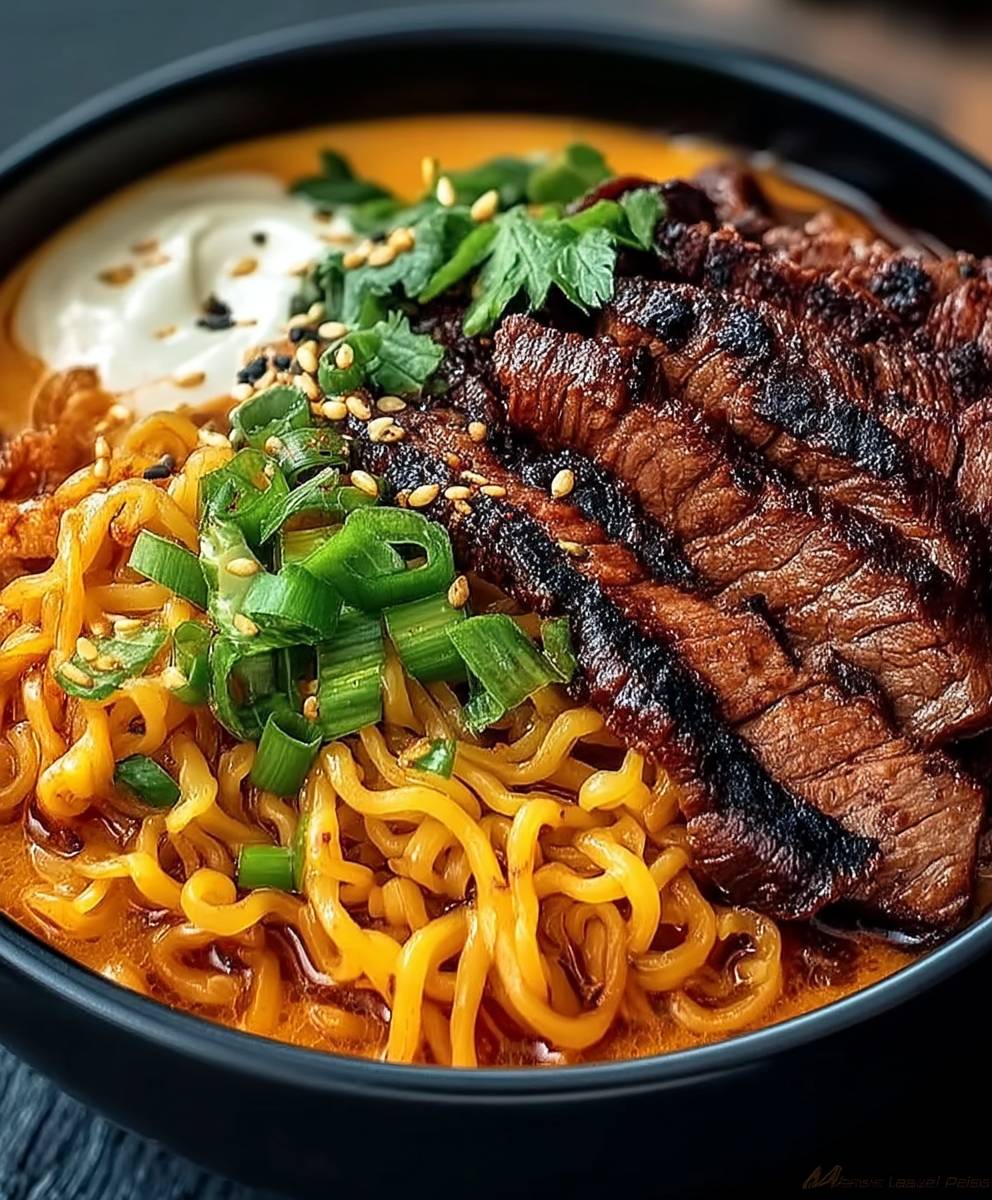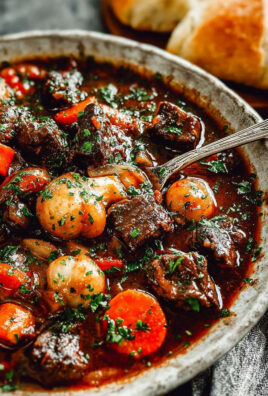Spicy Korean Ramen Beef: Prepare to embark on a culinary adventure that will ignite your taste buds and leave you craving more! Forget those instant noodles you’ve relied on in the past. We’re elevating ramen to a whole new level with this incredibly flavorful and satisfying dish. Imagine tender, marinated beef mingling with chewy ramen noodles, all swimming in a rich, spicy broth that’s both comforting and exhilarating.
Ramen, while often associated with Japan, has deep roots in Chinese noodle dishes. It made its way to Japan in the late 19th century and has since evolved into a diverse and beloved culinary staple. In recent years, Korean interpretations of ramen have exploded in popularity, adding their own unique spin with bold flavors and fiery spices. This Spicy Korean Ramen Beef recipe draws inspiration from both traditions, creating a fusion that’s both familiar and exciting.
What makes this dish so irresistible? It’s the perfect balance of textures and tastes. The tender beef provides a savory richness, while the ramen noodles offer a delightful chewiness. But the real star is the broth – a complex blend of spices, umami, and just the right amount of heat. It’s a dish that’s quick enough for a weeknight meal but impressive enough to serve to guests. Plus, who can resist a big bowl of comforting noodles, especially when they’re packed with so much flavor?
Ingredients:
- For the Ramen:
- 4 packets instant ramen noodles (Korean Shin Ramyun recommended for spice)
- 8 cups water
- For the Beef:
- 1 pound beef sirloin, thinly sliced against the grain
- 2 tablespoons soy sauce
- 1 tablespoon sesame oil
- 1 tablespoon gochujang (Korean chili paste)
- 1 teaspoon minced garlic
- 1/2 teaspoon ground ginger
- 1/4 teaspoon black pepper
- For the Vegetables:
- 1 tablespoon vegetable oil
- 1 medium onion, thinly sliced
- 2 cloves garlic, minced
- 1 red bell pepper, thinly sliced
- 1 green bell pepper, thinly sliced
- 4 ounces mushrooms, sliced (shiitake, cremini, or button)
- 2 green onions, thinly sliced, for garnish
- 1 cup bean sprouts
- 1/2 cup kimchi, chopped (optional, for extra spice and flavor)
- For the Broth Enhancement:
- 2 tablespoons soy sauce
- 1 tablespoon gochugaru (Korean chili flakes, adjust to taste)
- 1 teaspoon sugar
- 1 teaspoon fish sauce (optional, for umami)
- Optional Toppings:
- 2 soft-boiled eggs, halved
- Sesame seeds, for garnish
- Nori seaweed sheets, cut into strips
Preparing the Beef:
- In a medium bowl, combine the thinly sliced beef sirloin with the soy sauce, sesame oil, gochujang, minced garlic, ground ginger, and black pepper.
- Mix well, ensuring the beef is evenly coated with the marinade.
- Let the beef marinate for at least 15 minutes, or up to 30 minutes in the refrigerator. This allows the flavors to meld together and tenderize the beef. I usually prep this first so it has time to sit while I get everything else ready.
Sautéing the Vegetables and Beef:
- Heat the vegetable oil in a large pot or Dutch oven over medium-high heat.
- Add the sliced onion and cook until softened and translucent, about 3-5 minutes. Stir occasionally to prevent burning.
- Add the minced garlic and cook for another minute until fragrant. Be careful not to burn the garlic, as it can become bitter.
- Add the marinated beef to the pot and cook until browned on all sides, about 5-7 minutes. Make sure to break up any clumps of beef as it cooks.
- Add the sliced red and green bell peppers and sliced mushrooms to the pot. Cook until the vegetables are tender-crisp, about 3-5 minutes.
- If you’re using kimchi, add it to the pot now and cook for another minute, stirring to combine. The kimchi will add a wonderful depth of flavor and a spicy kick.
Cooking the Ramen and Enhancing the Broth:
- Pour the 8 cups of water into the pot with the sautéed vegetables and beef. Bring the mixture to a boil.
- Once boiling, add the ramen noodles to the pot. Cook according to the package directions, usually about 3-5 minutes. I like my noodles a little chewy, so I usually err on the side of undercooking them slightly.
- While the noodles are cooking, add the soy sauce, gochugaru (Korean chili flakes), sugar, and fish sauce (if using) to the pot. Stir well to combine and dissolve the sugar.
- Taste the broth and adjust the seasoning as needed. Add more gochugaru for extra spice, soy sauce for saltiness, or sugar for sweetness. Remember, you can always add more, but you can’t take it away!
- Add the bean sprouts to the pot during the last minute of cooking. They should be slightly crunchy.
Assembling and Serving:
- Divide the ramen noodles, beef, vegetables, and broth evenly among four bowls.
- Garnish each bowl with sliced green onions and sesame seeds.
- If desired, add a halved soft-boiled egg to each bowl. The creamy yolk adds richness and flavor to the ramen.
- You can also add strips of nori seaweed for an extra touch of umami.
- Serve immediately and enjoy! This Spicy Korean Ramen Beef is best enjoyed hot.
Tips and Variations:
- Spice Level: Adjust the amount of gochujang and gochugaru to your liking. If you’re sensitive to spice, start with a smaller amount and add more as needed.
- Beef Substitute: You can substitute the beef sirloin with other types of beef, such as ribeye or flank steak. You can also use ground beef or even thinly sliced pork.
- Vegetable Variations: Feel free to add other vegetables to the ramen, such as spinach, bok choy, or carrots.
- Broth Variations: For a richer broth, you can add a tablespoon of miso paste or a splash of rice wine vinegar.
- Egg Preparation: For perfectly soft-boiled eggs, bring a pot of water to a boil. Gently lower the eggs into the boiling water and cook for 6-7 minutes. Immediately transfer the eggs to an ice bath to stop the cooking process. Peel the eggs carefully and halve them before adding them to the ramen.
- Make it Vegetarian: To make this ramen vegetarian, omit the beef and fish sauce. Use vegetable broth instead of water. Add tofu or tempeh for protein.
- Leftovers: Leftover ramen can be stored in the refrigerator for up to 2 days. The noodles may absorb some of the broth, so you may need to add a little extra water when reheating.
Detailed Ingredient Notes:
Beef Selection:
Choosing the right cut of beef is crucial for this recipe. I highly recommend using sirloin because it’s relatively lean and tender, especially when sliced thinly against the grain. This ensures that the beef cooks quickly and remains tender in the ramen. If you can’t find sirloin, ribeye is another excellent option, although it’s a bit fattier. Flank steak can also work, but it’s important to slice it very thinly and marinate it for a longer period to tenderize it.
Gochujang and Gochugaru:
These are two essential Korean ingredients that contribute to the spicy and flavorful profile of this ramen. Gochujang is a fermented Korean chili paste that adds a deep, savory, and slightly sweet flavor. Gochugaru, on the other hand, is Korean chili flakes that provide a vibrant red color and a more direct spicy kick. The amount of each ingredient can be adjusted to your personal preference. If you’re new to Korean cuisine, start with a smaller amount and gradually increase it until you reach your desired level of spiciness. You can find these ingredients at most Asian grocery stores or online.
Ramen Noodle Choice:
While this recipe calls for instant ramen noodles for convenience, the type of ramen you choose can significantly impact the final result. I highly recommend using Korean Shin Ramyun noodles, as they are known for their chewy texture and spicy flavor. However, you can also use other types of instant ramen noodles, such as Sapporo Ichiban or Maruchan. If you prefer fresh ramen noodles, you can use those as well, but you’ll need to adjust the cooking time accordingly.
Mushroom Variety:
The type of mushrooms you use in this ramen is entirely up to you. Shiitake mushrooms are a classic choice for Asian cuisine, as they have a rich, earthy flavor. Cremini mushrooms are a more readily available option that also works well. Button mushrooms are the most common type of mushroom and can be used as a substitute. Feel free to experiment with different types of mushrooms to find your favorite combination.
Kimchi Considerations:
Kimchi is a fermented Korean side dish made from vegetables, typically napa cabbage and Korean radish, with a variety of seasonings. It adds a tangy, spicy, and umami-rich flavor to the ramen. If you’re using kimchi, make sure to chop it into smaller pieces before adding it to the pot. The amount of kimchi you use can be adjusted to your liking. If you’re not a fan of kimchi, you can omit it from the recipe altogether.
Soy Sauce Selection:
The type of soy sauce you use can also affect the flavor of the ramen. I recommend using a good-quality soy sauce
Conclusion:
This isn’t just another ramen recipe; it’s a flavor explosion waiting to happen! I truly believe this Spicy Korean Ramen Beef is a must-try for anyone who loves bold flavors, a little bit of heat, and a satisfyingly quick meal. The combination of the savory beef, the spicy gochujang, and the comforting ramen noodles creates a symphony of textures and tastes that will leave you craving more. It’s the perfect weeknight dinner when you’re short on time but don’t want to compromise on flavor.
But the best part? It’s incredibly versatile! Feel free to customize it to your liking. For a richer flavor, try using bone broth instead of regular broth. If you’re feeling adventurous, add some kimchi for an extra layer of fermented goodness and a tangy kick. A soft-boiled egg is always a welcome addition, adding creaminess and richness to the broth. And for those who prefer a vegetarian option, simply substitute the beef with tofu or mushrooms – they’ll soak up all the delicious flavors just as well.
Serving Suggestions and Variations:
* Garnish with Sesame Seeds and Scallions: A sprinkle of toasted sesame seeds and freshly chopped scallions adds a touch of elegance and a nutty aroma.
* Add a Soft-Boiled Egg: A perfectly cooked soft-boiled egg elevates the dish with its creamy yolk.
* Spice it Up (or Down!): Adjust the amount of gochujang to control the level of spiciness. If you’re sensitive to heat, start with a smaller amount and add more to taste.
* Vegetarian Option: Substitute the beef with firm tofu or shiitake mushrooms for a delicious vegetarian alternative.
* Kimchi Power: Add a spoonful of kimchi for a tangy and fermented flavor boost.
* Extra Veggies: Feel free to add other vegetables like bok choy, spinach, or bean sprouts for added nutrients and texture.
I’ve poured my heart into perfecting this recipe, and I’m confident that you’ll love it as much as I do. It’s the kind of dish that’s both comforting and exciting, familiar yet unique. The beauty of this Spicy Korean Ramen Beef lies in its simplicity and its ability to be adapted to your own personal preferences. Don’t be afraid to experiment with different ingredients and find your perfect combination.
So, what are you waiting for? Grab your ingredients, fire up your stove, and get ready to experience a flavor sensation. I promise you won’t be disappointed. And most importantly, I want to hear about your experience! Did you try any variations? What did you think of the spice level? Did you add any secret ingredients that took it to the next level?
Please, give this recipe a try and share your thoughts in the comments below. I’m always eager to learn from your culinary adventures and see how you’ve made this recipe your own. Happy cooking, and I can’t wait to hear what you think of this incredibly flavorful and satisfying Spicy Korean Ramen Beef! Let me know what you think!
Spicy Korean Ramen Beef: A Delicious and Easy Recipe
Spicy Korean Ramen with tender beef, flavorful vegetables, and a rich, umami broth. A quick and satisfying meal!
Ingredients
- 4 packets instant ramen noodles (Korean Shin Ramyun recommended for spice)
- 8 cups water
- 1 pound beef sirloin, thinly sliced against the grain
- 2 tablespoons soy sauce
- 1 tablespoon sesame oil
- 1 tablespoon gochujang (Korean chili paste)
- 1 teaspoon minced garlic
- 1/2 teaspoon ground ginger
- 1/4 teaspoon black pepper
- 1 tablespoon vegetable oil
- 1 medium onion, thinly sliced
- 2 cloves garlic, minced
- 1 red bell pepper, thinly sliced
- 1 green bell pepper, thinly sliced
- 4 ounces mushrooms, sliced (shiitake, cremini, or button)
- 2 green onions, thinly sliced, for garnish
- 1 cup bean sprouts
- 1/2 cup kimchi, chopped (optional, for extra spice and flavor)
- 2 tablespoons soy sauce
- 1 tablespoon gochugaru (Korean chili flakes, adjust to taste)
- 1 teaspoon sugar
- 1 teaspoon fish sauce (optional, for umami)
- 2 soft-boiled eggs, halved
- Sesame seeds, for garnish
- Nori seaweed sheets, cut into strips
Instructions
- Preparing the Beef: In a medium bowl, combine the thinly sliced beef sirloin with the soy sauce, sesame oil, gochujang, minced garlic, ground ginger, and black pepper. Mix well, ensuring the beef is evenly coated with the marinade. Let the beef marinate for at least 15 minutes, or up to 30 minutes in the refrigerator.
- Sautéing the Vegetables and Beef: Heat the vegetable oil in a large pot or Dutch oven over medium-high heat. Add the sliced onion and cook until softened and translucent, about 3-5 minutes. Add the minced garlic and cook for another minute until fragrant. Add the marinated beef to the pot and cook until browned on all sides, about 5-7 minutes. Add the sliced red and green bell peppers and sliced mushrooms to the pot. Cook until the vegetables are tender-crisp, about 3-5 minutes. If you’re using kimchi, add it to the pot now and cook for another minute, stirring to combine.
- Cooking the Ramen and Enhancing the Broth: Pour the 8 cups of water into the pot with the sautéed vegetables and beef. Bring the mixture to a boil. Once boiling, add the ramen noodles to the pot. Cook according to the package directions, usually about 3-5 minutes. While the noodles are cooking, add the soy sauce, gochugaru (Korean chili flakes), sugar, and fish sauce (if using) to the pot. Stir well to combine and dissolve the sugar. Taste the broth and adjust the seasoning as needed. Add the bean sprouts to the pot during the last minute of cooking.
- Assembling and Serving: Divide the ramen noodles, beef, vegetables, and broth evenly among four bowls. Garnish each bowl with sliced green onions and sesame seeds. If desired, add a halved soft-boiled egg to each bowl. You can also add strips of nori seaweed. Serve immediately and enjoy!
Notes
- Spice Level: Adjust the amount of gochujang and gochugaru to your liking.
- Beef Substitute: You can substitute the beef sirloin with other types of beef, such as ribeye or flank steak. You can also use ground beef or even thinly sliced pork.
- Vegetable Variations: Feel free to add other vegetables to the ramen, such as spinach, bok choy, or carrots.
- Broth Variations: For a richer broth, you can add a tablespoon of miso paste or a splash of rice wine vinegar.
- Egg Preparation: For perfectly soft-boiled eggs, bring a pot of water to a boil. Gently lower the eggs into the boiling water and cook for 6-7 minutes. Immediately transfer the eggs to an ice bath to stop the cooking process. Peel the eggs carefully and halve them before adding them to the ramen.
- Make it Vegetarian: To make this ramen vegetarian, omit the beef and fish sauce. Use vegetable broth instead of water. Add tofu or tempeh for protein.
- Leftovers: Leftover ramen can be stored in the refrigerator for up to 2 days. The noodles may absorb some of the broth, so you may need to add a little extra water when reheating.







Leave a Comment